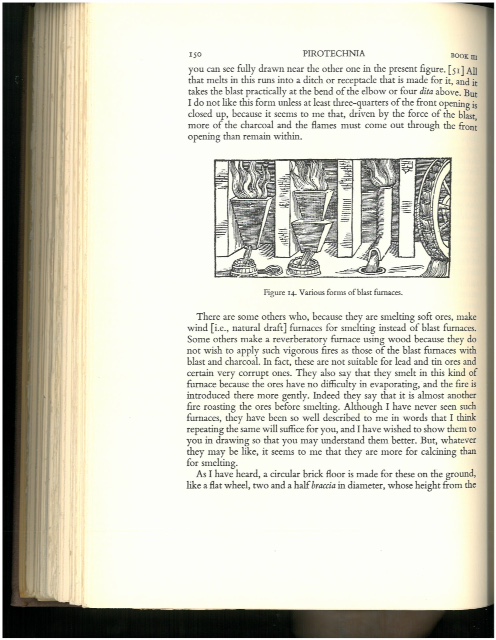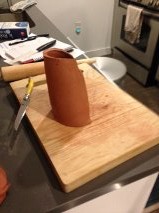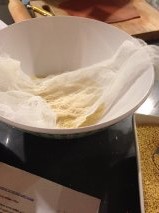NAME: Giulia Chiostrini and Jef Palframan
DATE AND TIME: 5: 30 pm, January 29, 2015
LOCATION: 20th floor apartment, Brooklyn, NY
- SUBJECT: Historical Recipe Reconstruction –
For Making Millas Folio 020r
<title id=”p020r_a1”>For making millas</title>
<ab id=“p020r_b1a”>You must have some millet soaked in order to remove the chaff and then clean it well. Next you must grind it again quite finely and pass through a cloth sieve. One must
soak the flour with fresh melted butter and some milk so that it is very light, like the pastry to make beignets, and add egg yolk depending on the amount of flour, so that there are two egg yolks for each millas. Then you will put in some saffron if you want to give them a little colour.</ab>
<ab id=“p020r_b1b”>Afterwards you must have some moulds, which must be made from terra[cotta], like a furnace for catholic hats but it must be open at both ends. And then, having made a good fire, clean where you want to put your millas and then take your molds and grease them very well so that the pastry does not stick to them when baked. Once you have done that, put your molds in a place in the oven where you clean and sprinkle a bit of flour on the bottom and fill them with some of the aforementioned pastry. Then you will cover the said molds, with a lid made like the mould, but it must be bigger and not open at the top. Then once done, you will put some straw on the said lid and a lot of hot charcoal, and set a fire around it, once done, you will […] one from it after a bit of time and will see when it is baked, it will be hard.</ab>
I session
We discussed the recipe, and we exchanged our interpretations of certain passages of the recipe, including the ‘terracotta, like a furnace for catholic hats but it must be opened at both ends’. -We looked for similar terminology in the manuscript recipes and we found that P006va1 mentions a similar kind of furnace "....A cane can be stretched out as long as you want in a small furnace made like a reverbatory oven but with openings on both sides"We did a general search online, and it came out that a story from Book of Daniel (bible) narrates about King Nebuchadneztar punishing three men; those three men were burned in a furnace with their hats, coats, garments and shoes because they refused to worship the golden statue of the King. In this case, the author could have used this story as an idiom to describe the furnace he meant in the recipe text.
We also know that a catholic hat has two holes, one on the bottom and one on the top, sharing similarities with the images of furnace reported in Biringuccio’s Pirotechnia book.

We couldn’t find any early modern millas recipes. Only one recipe from Scappi’s Culinary treatise, entitled “Per far la Minestra di Miglio e Panico Infranto” in Cap. CLXXXVI, tells us about PANICO (in English millet) as a good grain with a strong taste. In many of Scappi’s recipes, we also found saffron mentioned within the same formula of recipes in different languages, including our millas recipe: “if you want to give them a little color”.
We found that millet grain is used in contemporary recipes from online sources like http://allrecipes.com/Recipe/Ezekiel-Bread-I/
We also consulted online sources in order to find recipe for bigne’ pastry:
http://ricette.giallozafferano.it/Pasta-per-choux.html
We decided to use two ceramic bowls; one as a mold, the other piece works as a lid, which has to be bigger than the mold as mentioned in the recipe.
We decided to reconstruct three different shaped molds made with brown clay in order to imitate the mentioned terracotta molds. We shaped the first mold as a little chimney open at both ends as described in the recipe.

We shaped the second mold as a flower with big open petals. The third one had a shape of a small dish with a thick edge, and we also made a lid for this particular shape.
We ground our own flour from the millet grain using a mortar. We were able to grind one tablespoon of grain every 10 minutes. The recipe doesn’t mention a specific quantity of any of the ingredients used. According to modern baking recipes that includes millet grain, 1 cup of flour is sufficient to obtain a good amount of dough; It took one hour to produce one cup of flour from the millet grain. Our arms started to hurt. However, we decided to grind a total of 3 millet grain cups.
After grinding it, we passed the flour through a cheesecloth to clean it from impurity. We also tried do not waste any of the ground grain, thinking that at the contemporary time of the recipe, the executor of the recipe will have had the same accuracy.

We also agreed that it was impossible to use charcoal and some straw in a modern oven (issue of authenticity)
NAME: Giulia Chiostrini and Jef Palframan
DATE AND TIME: 5: 30 pm, February 1st, 2015
LOCATION: 20th floor apartment, Brooklyn, NY
SUBJECT: Historical Recipe Reconstruction – For Making Millas (p020r)
Table of Contents
Ingredients
- 3 cups of ground millet grain
- 2 egg yolks
- 1 cup milk
- 3 tablespoons of melted butter
- Saffron
- Lard for greasing the molds
Equipment
- One plastic bowl to mix the ingredients (issue of authenticity)
- a wooden mix
- cup measurements (issue of authenticity)
- Ceramic bowls
- 3 clay molds
At room temperature we poured 1 cup of flour in the plastic bowl and we mixed it with one cup of milk. The consistency of the dough was too liquid, so we decided to add other 2 cups of flour, for a total of three cups.
We add the butter, after melting it on the stove at low fire
Once the dough reached a soft consistency, we greased the molds using lard in abundance, and we placed a small amount of dough in each of the four molds.
In the pre - heated oven at 350 degrees, we let the dough bake for 40 minutes. This is the result.
| The Millis baked in the ceramic bowl |
Observations
- I found the recipe text fascinating. I enjoyed working on the interpretation of the text and researching similarities in other early modern sources as well as in modern sources. Reconstruction of the recipe becomes an ‘authentic’ experience of interpretation.
- Millet grain is a local product in South France and in Italy.
- While the Millas were baking, a pleasant smell was coming out from the oven. At the first byte, the Millas flavor was similar to that one of corn bread. However, the byte left a light bitter taste in our mouth. We should have soak the grain for a few hours before grinding them. Similar procedure it's used in modern time for cooking lentils, for example.
- Context: the Millas recipe is followed by a recipe for making glass. Why? Why the author combined these two different recipes in the same page?